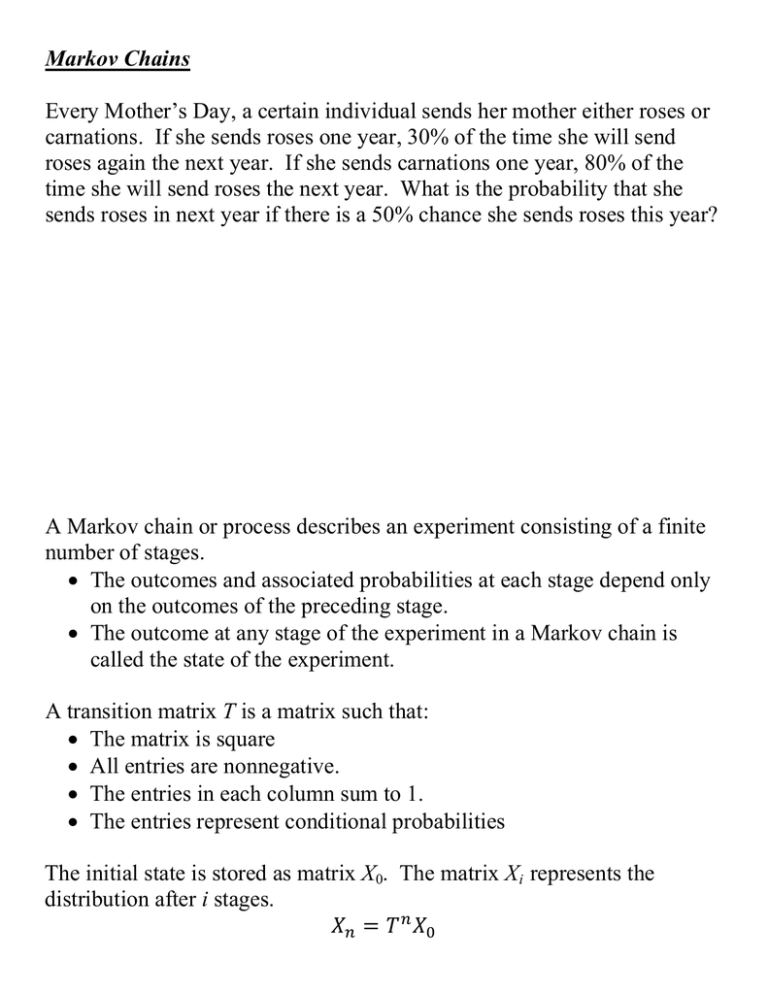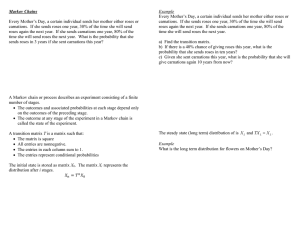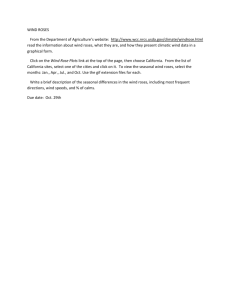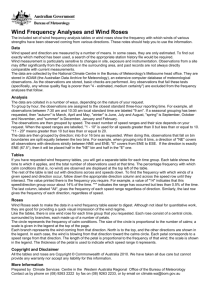Markov Chains
advertisement

Markov Chains Every Mother’s Day, a certain individual sends her mother either roses or carnations. If she sends roses one year, 30% of the time she will send roses again the next year. If she sends carnations one year, 80% of the time she will send roses the next year. What is the probability that she sends roses in next year if there is a 50% chance she sends roses this year? A Markov chain or process describes an experiment consisting of a finite number of stages. The outcomes and associated probabilities at each stage depend only on the outcomes of the preceding stage. The outcome at any stage of the experiment in a Markov chain is called the state of the experiment. A transition matrix T is a matrix such that: The matrix is square All entries are nonnegative. The entries in each column sum to 1. The entries represent conditional probabilities The initial state is stored as matrix X0. The matrix Xi represents the distribution after i stages. Example Every Mother’s Day, a certain individual sends her mother either roses or carnations. If she sends roses one year, 30% of the time she will send roses again the next year. If she sends carnations one year, 80% of the time she will send roses the next year. a) Find the transition matrix. b) If there is a 40% chance of giving roses this year, what is the probability that she sends roses in ten years? c) Given she sent carnations this year, what is the probability that she will give carnations again 10 years from now? The steady state (long term) distribution of is X L and TX L X L . Example What is the long term distribution for flowers on Mother’s Day? Example A study has shown that a family living in the state of Denial typically takes a vacation once per year. The vacations can be in-state, out-of-state or international. The transition matrix is IS IS T OS IT OS IT 0.10 0.20 0.60 0.50 0.25 0.35 0.40 0.55 0.05 What is the long term distribution of vacation destinations? Example A company offers three different cars to its executives each year. Those who have a brand A car ask for a brand A car again 30% of the time, they ask for a brand B car 30% of the time and a brand C car 40% of the time. Those who are driving a brand B car ask for a brand A car 50% of the time and a brand C car 50% of the time. Those who are driving a brand C car ask for a brand C car all of the time. a) Find the transition matrix for this Markov process. b) What is the long term distribution of cars? A transition matrix T is a regular Markov chain if the sequence T, T2, T3,… approaches a steady state matrix with all positive entries. An absorbing transition matrix has the following properties: 1. There is at least one absorbing state 2. It is possible to go from any non-absorbing state to an absorbing state in one or more stages. An absorbing state is a unit column with the 1 on the main diagonal. Example Classify the following matrices as regular, absorbing, neither, or not a transition matrix. 0.9 0.2 0.1 0.8 0.7 1 0.3 0 1 0.5 0 0.5 .3 .1 .4 .2 0 1 0 .5 0 1 0 0 0 .5 0 0 .3 .2 0 .7 .8 0 0 0 1 I S Absorbing stochastic matrices can be rewritten as 0 R I S ( I R) The steady state solution is 0 0 1 A B C D A C é1 1/ 8 0 0 ù A ê ú B ê0 5 / 8 0 0 ú C ê ú ê C 0 0 1 1/ 6 ú B ê ú D êë0 1/ 4 0 5 / 6úû D A A C é ê C ê ê B ê ê D êë A B D ù ú ú ú ú ú ú û é ê ê ê ê ê ê ë B D ù ú ú ú ú ú ú û The matrix F I R is called the fundamental matrix and the entry fij gives the expected number of times the system will be in the ith nonabsorbing if it is initially in the jth nonabsorbing state. 1 The sum of the entries in the jth column of F is the expected number of stages before absorption if the system was initially in the jth nonabsorbing state. Example A person plays a game in which the probability of winning $1 is 0.50 and the probability of losing $1 is 0.50. If she goes broke or reaches $4, she quits. Find the long-term behavior if she starts with $1, $2, or $3.





